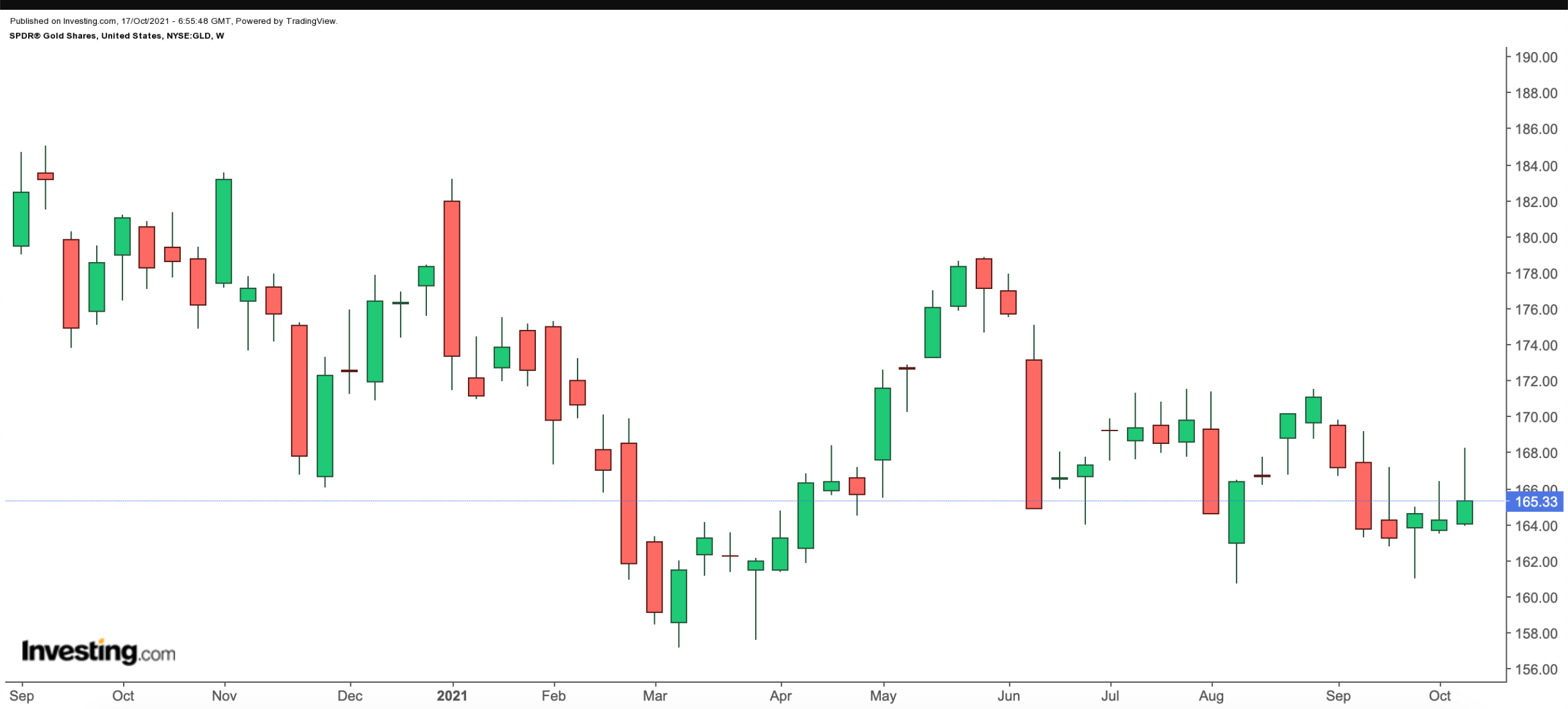US President Joe Biden recently signed a bill increasing the country's debt limit until early December. Although the US will meet its financial obligations for the time being, question marks still remain as to what might happen toward the end of the year.
Wall Street is pleased that default is off the table for the next several weeks. Now, markets hope there will not be a government shutdown, which requires a federal funding bill. However, political posturing and partisanship might mean increased volatility for equities.
Therefore, today's article introduces two exchange-traded funds (ETFs) that could be appropriate for choppiness over the rest of the year.
1. SPDR Gold Shares
- Current Price: $165.33
- 52-Week Range: $157.13 - $183.53
- Expense Ratio: 0.40%
So far in 2021, the price of gold is down about 7%. By comparison, the S&P 500 index is up around 19%.
The shiny metals tends to do well when there is fear or increased volatility in equities. Therefore, those readers who believe stocks could come under pressure in the weeks ahead might consider researching an ETF that tracks gold.
An example would be the SPDR® Gold Shares (NYSE:GLD), which began trading in November 2004. Assets under management are close to $56.5 billion.

In addition to worries about raising the US debt ceiling, Wall Street is getting ready for the Fed to taper and reduce its asset buying as well as issue more hawkish statements. As a result, many analysts concur that the last quarter of 2021 remains a wild card for equities.
In the coming days, the $160-level in GLD is likely to act as support and the $170-level as resistance. If bulls have the upper hand, then $180 could well be the next target, possibly in 2022.
Those readers who expect gold to make another attempt at $170 and higher in the coming weeks could consider buying the dips in the price of gold.
2. Global X NASDAQ 100 Covered Call ETF
- Current Price: $22.68
- 52-Week Range: $20.51 - $23.58
- Distribution Yield: 12.33%
- Expense Ratio: 0.60% per year
In the search for calmer waters, a niche area that gets increased attention is covered call ETFs. We have discussed covered calls with examples before (for example, here and here).
The Global X NASDAQ 100 Covered Call ETF (NASDAQ:QYLD) follows a "buy-write" or "covered call" strategy. QYLD first buys all the stocks in the NASDAQ 100 index. The fund then "sells" or "writes" monthly at-the-money index call options. The aim is to generate income through covered call writing, which generally offers a better yield when volatility increases.

The fund points out the differences between index options and single stock options. For instance, traders can exercise single stock options at any time. But, on the other hand, index options cannot be exercised (or called) early.
Because index options cannot be exercised early, meaning before expiry, the level at which the index finishes the expiry month is the most important thing for the fund. All other price moves that happen throughout the month are irrelevant. On a side note, index options are settled in cash. In other words, the index holdings are not delivered.
Since its inception in December 2013, net assets in QYLD have reached $4.85 billion. The top ten holdings comprise around 55% of the fund. Leading five names are Apple (NASDAQ:AAPL), Amazon (NASDAQ:AMZN), Microsoft (NASDAQ:MSFT), Facebook (NASDAQ:FB) and Alphabet (NASDAQ:GOOGL) (NASDAQ:GOOG).
So far in 2021, the NASDAQ 100 index and Invesco QQQ Trust (NASDAQ:QQQ), which tracks the returns of the index, are up around 17.5%.
On the other hand, QYLD, which invests in the same securities as the QQQ fund but then writes call options on the entirety of the holdings, is down about 0.5% YTD (i.e., about flat). However, QYLD's 12-month distribution yield stands at 12.33%. An investor would have received this yield if the ETF were held over that period. QYLD makes payments monthly.
When a fund, such as QYLD, writes a call option, it collects a premium from the option buyer. These premiums enable the fund to pay out this income. At the end of the month, QYLD distributes a portion of that income from selling the NDX index option to fund holders. Then, as a new month begins, the process is repeated.
Put another way, this premium means income in sideways markets as well as some protection in declining markets.
However, readers should note that covered calls limit a fund's gains in a rising market. For instance, although the NASDAQ 100 index has gone up about 27% over the last 12 months, QYLD increased by 4%. However, in addition, QYLD had a distribution yield of 12.89%.
Call options sold every month cap the returns of QYLD. In exchange for receiving the monthly premium, with covered call funds, investors give up any potential upside later. During the months the index rises above the strike price of the index call option, the fund's gain is limited by the premium of the option sold.
Like any other asset class or ETF, QYLD's risk/return profile may not suit all investors. But, this fund might appeal to retirees and income investors, who may be ready to forego upside potential in exchange for more regular monthly distributions.
